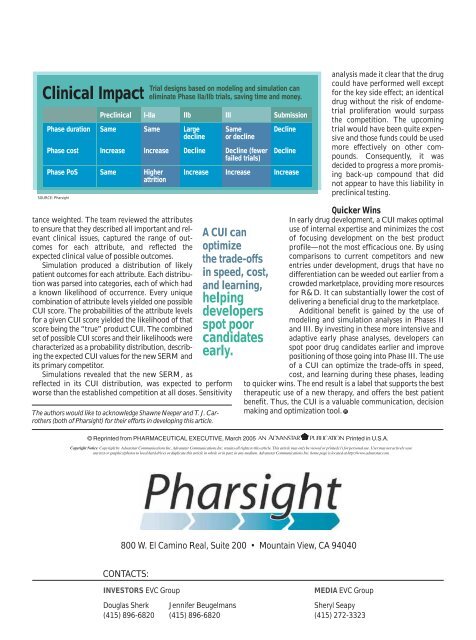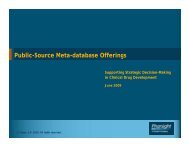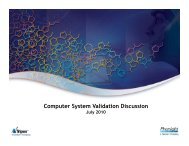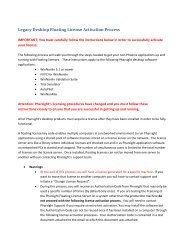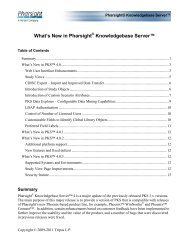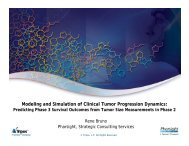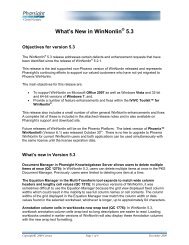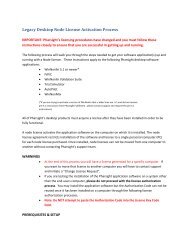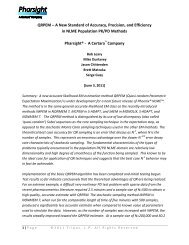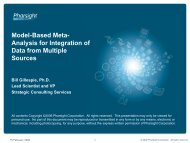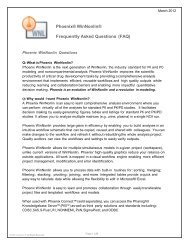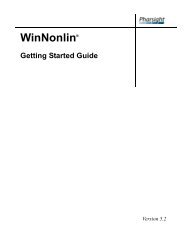A clinical utility index (CUI) openly evaluates a product's attributes ...
A clinical utility index (CUI) openly evaluates a product's attributes ...
A clinical utility index (CUI) openly evaluates a product's attributes ...
Create successful ePaper yourself
Turn your PDF publications into a flip-book with our unique Google optimized e-Paper software.
Clinical Impact<br />
SOURCE: Pharsight<br />
tance weighted. The team reviewed the <strong>attributes</strong><br />
to ensure that they described all important and relevant<br />
<strong>clinical</strong> issues, captured the range of outcomes<br />
for each attribute, and reflected the<br />
expected <strong>clinical</strong> value of possible outcomes.<br />
Simulation produced a distribution of likely<br />
patient outcomes for each attribute. Each distribution<br />
was parsed into categories, each of which had<br />
a known likelihood of occurrence. Every unique<br />
combination of attribute levels yielded one possible<br />
<strong>CUI</strong> score. The probabilities of the attribute levels<br />
for a given <strong>CUI</strong> score yielded the likelihood of that<br />
score being the “true” product <strong>CUI</strong>. The combined<br />
set of possible <strong>CUI</strong> scores and their likelihoods were<br />
characterized as a probability distribution, describing<br />
the expected <strong>CUI</strong> values for the new SERM and<br />
its primary competitor.<br />
Simulations revealed that the new SERM, as<br />
reflected in its <strong>CUI</strong> distribution, was expected to perform<br />
worse than the established competition at all doses. Sensitivity<br />
The authors would like to acknowledge Shawne Neeper and T. J. Carrothers<br />
(both of Pharsight) for their efforts in developing this article.<br />
Trial designs based on modeling and simulation can<br />
eliminate Phase IIa/IIb trials, saving time and money.<br />
Pre<strong>clinical</strong> I-IIa IIb III Submission<br />
Phase duration Same Same Large Same Decline<br />
decline or decline<br />
Phase cost Increase Increase Decline Decline (fewer Decline<br />
failed trials)<br />
Phase PoS Same Higher Increase Increase Increase<br />
attrition<br />
A <strong>CUI</strong> can<br />
optimize<br />
the trade-offs<br />
in speed, cost,<br />
and learning,<br />
helping<br />
developers<br />
spot poor<br />
candidates<br />
early.<br />
analysis made it clear that the drug<br />
could have performed well except<br />
for the key side effect; an identical<br />
drug without the risk of endometrial<br />
proliferation would surpass<br />
the competition. The upcoming<br />
trial would have been quite expensive<br />
and those funds could be used<br />
more effectively on other compounds.<br />
Consequently, it was<br />
decided to progress a more promising<br />
back-up compound that did<br />
not appear to have this liability in<br />
pre<strong>clinical</strong> testing.<br />
Quicker Wins<br />
In early drug development, a <strong>CUI</strong> makes optimal<br />
use of internal expertise and minimizes the cost<br />
of focusing development on the best product<br />
profile—not the most efficacious one. By using<br />
comparisons to current competitors and new<br />
entries under development, drugs that have no<br />
differentiation can be weeded out earlier from a<br />
crowded marketplace, providing more resources<br />
for R&D. It can substantially lower the cost of<br />
delivering a beneficial drug to the marketplace.<br />
Additional benefit is gained by the use of<br />
modeling and simulation analyses in Phases II<br />
and III. By investing in these more intensive and<br />
adaptive early phase analyses, developers can<br />
spot poor drug candidates earlier and improve<br />
positioning of those going into Phase III. The use<br />
of a <strong>CUI</strong> can optimize the trade-offs in speed,<br />
cost, and learning during these phases, leading<br />
to quicker wins. The end result is a label that supports the best<br />
therapeutic use of a new therapy, and offers the best patient<br />
benefit. Thus, the <strong>CUI</strong> is a valuable communication, decision<br />
making and optimization tool.<br />
© Reprinted from PHARMACEUTICAL EXECUTIVE, March 2005 Printed in U.S.A.<br />
Copyright Notice Copyright by Advanstar Communications Inc. Advanstar Communications Inc. retains all rights to this article. This article may only be viewed or printed (1) for personal use. User may not actively save<br />
any text or graphics/photos to local hard drives or duplicate this article in whole or in part, in any medium. Advanstar Communications Inc. home page is located at http://www.advanstar.com.<br />
800 W. El Camino Real, Suite 200 • Mountain View, CA 94040<br />
CONTACTS:<br />
INVESTORS EVC Group<br />
Douglas Sherk<br />
(415) 896-6820<br />
Jennifer Beugelmans<br />
(415) 896-6820<br />
MEDIA EVC Group<br />
Sheryl Seapy<br />
(415) 272-3323


